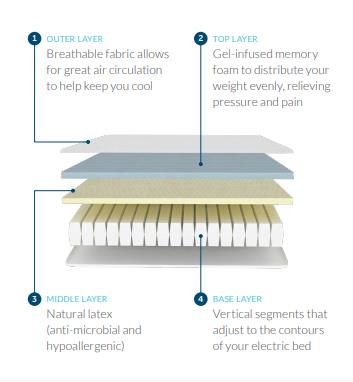By Jo Joiner
Bet you know someone with an electric bed. They’ve probably told you about how much fun it is to adjust the bed and how much better they’re sleeping. In this 8hours article, we look at why people get adjustable (electric) beds and features to look for when you’re buying.
What is an adjustable bed?
The best adjustable bed models have an electrically-operated bed frame and a special mattress that’s able to flex around the frame shape. There are usually two electric motors in the frame – one to raise the head end of the bed and another to raise the feet end. You can make the frame change shape using a remote control. Adjustable beds are really taking off in New Zealand and are literally changing the shape of how we sleep.
The benefits of an electric bed
The main reason to get an electric bed is to improve the quality of your sleep. By adjusting the bed in various ways, you can relieve various kinds of pain and discomfort that are preventing you from falling and staying asleep. Here’s what we mean:
- Relieve lower back pain. Elevated knees and a slight upper body incline can support the natural curve of your spine and relieve lumbar discomfort. It’s a position that can also improve blood circulation, which is good for healing and reducing inflammation.
- Relieve leg aches and pains. The feet-up position helps to soothe aching feet and legs. It also helps with swollen legs or feet.
- Minimise snoring. The head-up position helps to minimise snoring and make breathing easier.
- Difficulty getting in and out of bed. For older people and those recovering from an illness, the knees-raised and head-raised position makes it easier to get in and out of bed.
- Reduce reflux. Head of bed elevation helps to manage gastroesophageal reflux disease (GERD). It limits how often stomach acid escapes to the oesophagus and allows your body to get stomach acid back to your stomach quicker.
- Relieve asthma. Elevating the upper body can be a good thing for sleepers with asthma. When you’re lying flat, airways are more restricted.
- Reduce sleep apnoea. As mentioned above for asthma, lying flat restricts airways. By elevating the head end of the bed there’s less chance of apnoea issues.
- Reduce arthritis pain. By raising the head end or foot end – or both – affected limbs can be better supported, increasing the chance of a good night’s sleep.
Electric bed positions
There are four main configurations you can use, but all are variable. Using the remote control, you can have exactly the slope you need at the head or feet (or both). And of course adjustable beds can be used entirely flat, like a regular bed. This means you can have two king-singles pushed together to make a split king adjustable bed; one sleeper can adjust their bed and the other can sleep on a flat surface. Everybody’s happy!

Do you need a special mattress for an adjustable bed?
Yes you do. Adjustable beds have special mattresses that are able to flex with the bed base, without becoming distorted or damaged. For example, the Dreamland iFlex 3 three-layer memory foam and latex hybrid mattress has vertical segments in the base layer that allow the mattress to conform perfectly to the shape of the bed base. Two levels of firmness are available – Fitness (medium-firm) and Balance (medium-soft). See more about iFlex mattresses on our mattresses page.
In this diagram you can see how Dreamland iFlex 3 mattresses are constructed.

Tips for buying an electric bed
- Check the warranties – there should be one for the frame and another for the electronics.
- Look for a specialised adjustable bed mattress that includes natural latex, which is antimicrobial and hypoallergenic.
- Try the bed out in all positions and check that the mattress’s upper surface remains smooth when flexed. It shouldn’t get all bunched up.
- Enquire about the quality of the electric motors. Where were they designed? For example, Dreamland eFlex beds have German-designed motors.
Find an adjustable bed stockist
You can find Dreamland eFlex/iFlex adjustable beds at retailers throughout the North Island. See stockists.







